A neutron star is the collapsed core of a giant star. If a star’s collapsed core had between 20 and 29 solar masses, it will result in a new neutron star.
Key Facts & Summary
- Neutron stars are among the smallest and densest stars, excluding black holes, and hypothetical white holes.
- Neutron stars typically have a radius of 10 km / 6.2 mi and a mass of around 1.4 to 3.2 solar masses.
- Neutron stars result out of supernova explosions of massive stars, combined with gravitational collapse, which compresses the core past the white dwarf star density, to that of an atomic nucleus.
- They are basically the stellar corpse of a massive star when it goes supernova.
- Neutron stars have a prevalence of around 0.7% and are usually of spectral type D.
- These tiny stars have temperatures of around 600.000 K, however, they aren’t very luminous.
- Neutron stars live up to around 100,000 to 10 billion years.
- Neutron stars consist of neutron particles that are a bit more massive than photons with no electrical charge.
- It is possible for neutron stars to further collapse into black holes if they have more than 3 solar masses.
- Only neutron stars that have high spin rates and more than three solar masses may resist the black hole process-phase.
- Some good examples of neutron stars are PSR J0108-1431 and PSR B1509-58.
- Neutron stars no longer actively generate heat after formation, and they cool over time, though they may still evolve further through collision or accretion.
- Neutron stars have powerful magnetic fields, around 100 million to 1 quadrillion times stronger than Earth’s magnetic field.
- The gravitational field on a neutron star’s surface is 200 billion times that of Earth’s.
- These stars are so dense, that a normal-sized matchbox containing neutron-star material would weigh about 3 billion tonnes.
Formation
Any main-sequence star with an initial mass of above 8 solar masses, has the potential to become a neutron star. As the star evolves away from the main-sequence subsequent nuclear burning produces an iron-rich core.
When all nuclear fuel in the core is exhausted, the core must be supported by degeneracy pressure alone. Further deposits of mass from shell-burning causes the core to exceed the Chandrasekhar limit.
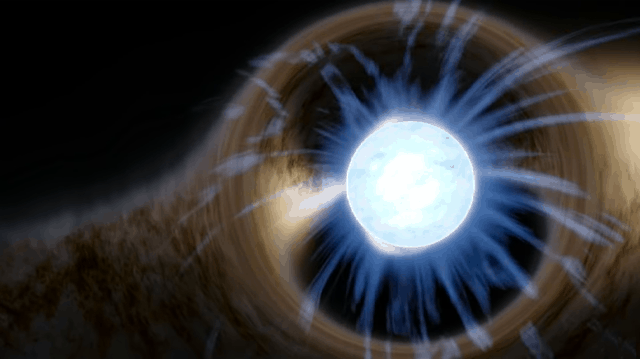
Electron-degeneracy pressure is overcome and the core collapses further, causing temperatures to rise higher. The higher temperature causes photodisintegration.
Temperatures continue to rise and thus electrons and photons combine to form neutrons via electron capture, releasing a flood of neutrinos.
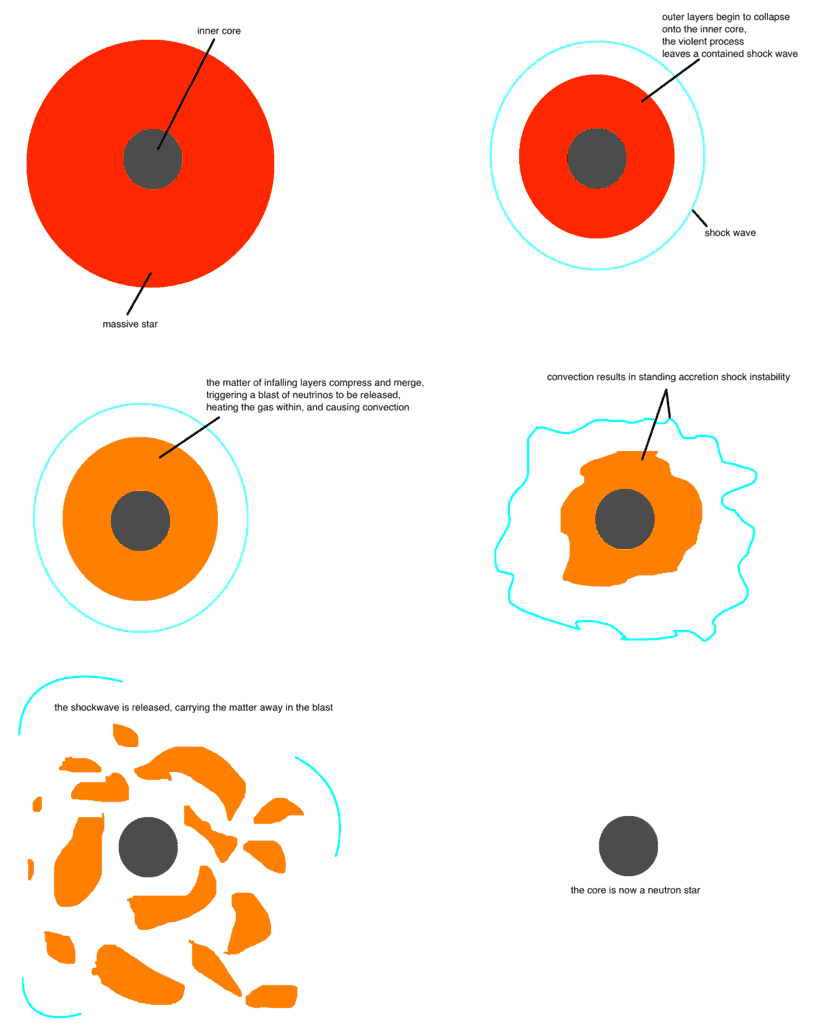
When densities reach a critical state, a combination of strong force repulsion and neutron degeneracy pressure halts the contraction. The infalling outer envelope of a star is halted and flung outwards by a flux of neutrinos produced in the creation of the neutrons, becoming a supernova.
The stellar remnant which is left becomes a neutron star. If the star remnant has around 3 solar masses, it will further collapse to become a black hole.
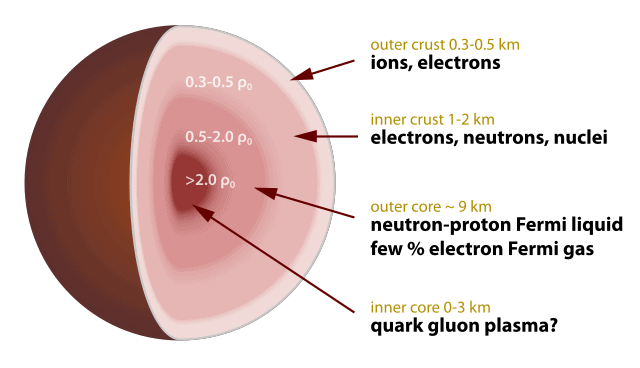
Since now the star has only a tiny fraction of its former radius, it will have a high rotational speed, that will over time slow down. Some neutron stars have rotation periods from about 1.4 ms to 30 s.
Due to the neutron star’s now high density, its surface gravity has also risen to hundreds of times more powerful than the surface gravity on Earth.
Characteristics
A neutron star typically has around 1.1 solar masses. The upper limit of mass for a neutron star is called the Tolman-Oppenheimer-Volkoff limit. This limit is generally held at 2.1 solar masses.
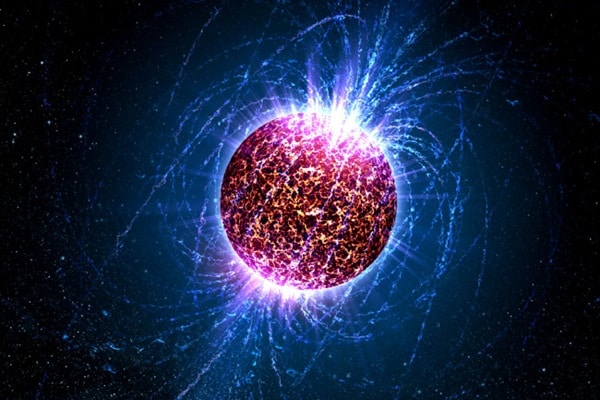
It is believed that if a stellar remnant has more than 2.16 solar masses, it will overcome the strong force repulsion and neutron degeneracy pressure, and thus gravitational collapse will occur.
This will produce a black hole, however, the smallest observed mass of a stellar black hole is about 5 solar masses. Most of the light generated by a neutron star is emitted in X-rays.
Density and pressure
Neutron stars are so dense, that a normal-sized matchbox containing neutron-star material would weigh about 3 billion tonnes, while the gravitational field on a neutron star’s surface is 200 billion times that of Earth’s.
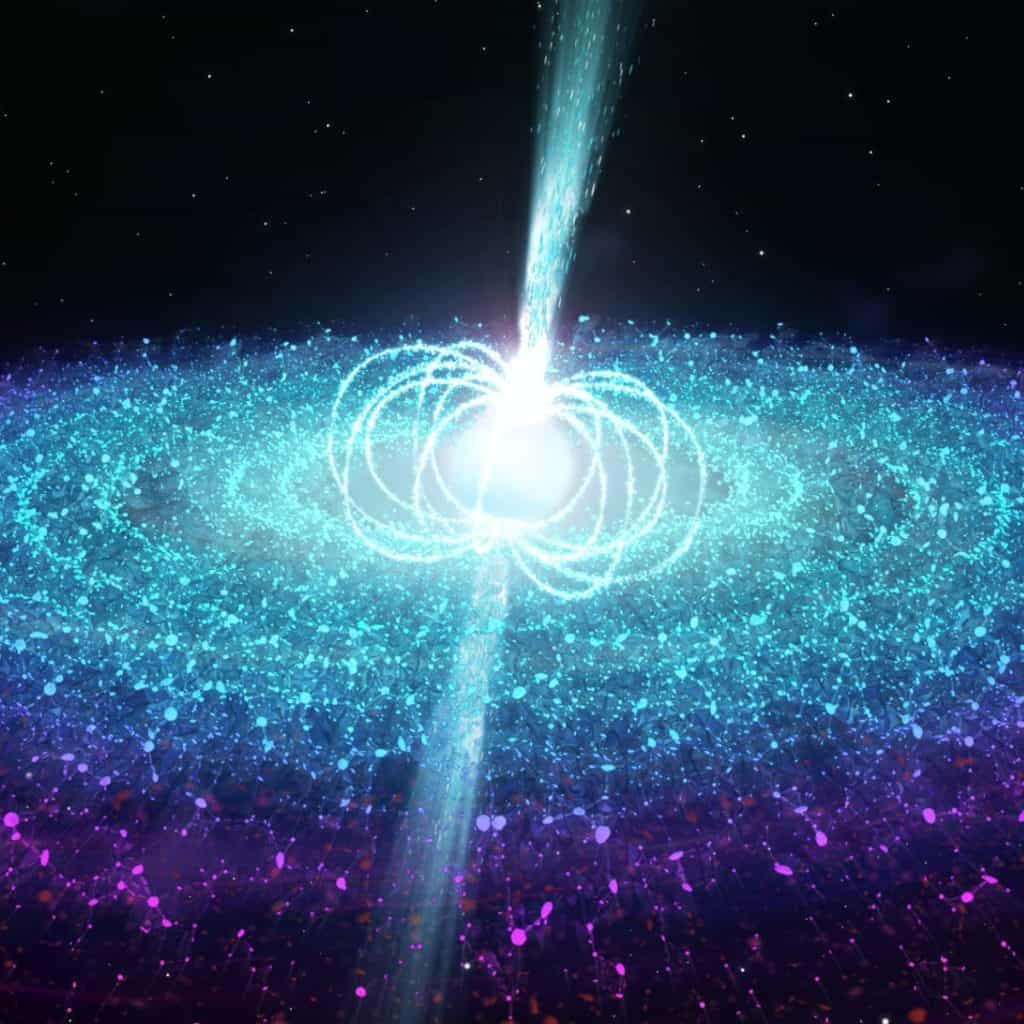
Magnetic Field
The magnetic field strength on the surface of a neutron star ranges from around 104 to 1011 tesla. These are orders of magnitude higher than in any other object.
There are some variations in the magnetic field of neutron stars, and they are the most likely factor which allows for different types of neutron stars to be distinguished by their spectra and explains the periodicity of pulsars.
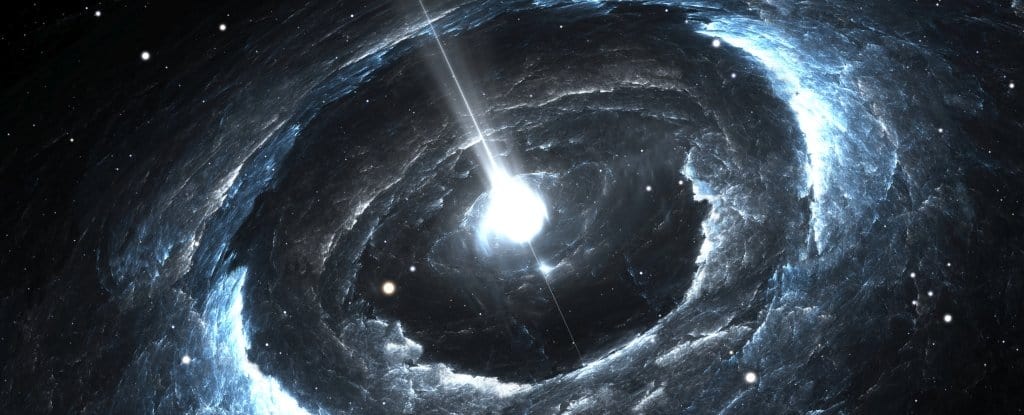
The neutron stars known as magnetars have the strongest magnetic fields, so much so that photons can merge or split in two, and virtual particle-antiparticle pairs are produced. Some neutron stars have magnetic fields of around 100 million to 1 quadrillion times stronger than Earth’s magnetic field.
Pulsars
Most neutron stars are observed as pulsars. Pulsars are rotating neutron stars, that display pulsation of radiation at very regular intervals that range from milliseconds to seconds.
They have strong magnetic fields, which funnel jets of particles through their two magnetic poles. These accelerated particles produce a very powerful beam of light, some might say that they look like lighthouses.
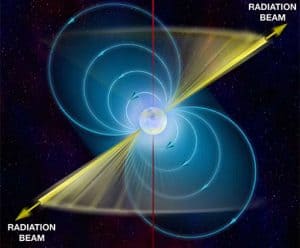
It is common for pulsars to not have their magnetic field aligned with their spin axis, thus the beams of particles and light are swept around as the star rotates. If the beam crosses our line-of-sight, we see a pulse.
Location
Currently, there are around 2,000 known neutron stars detected in the Milky Way, and the Magellanic Clouds, the majority of which have been detected as radio pulsars.
Neutron stars are mostly concentrated along the disk of the Milky Way. Neutron stars have a prevalence of around 0.7% and are usually of spectral type D.
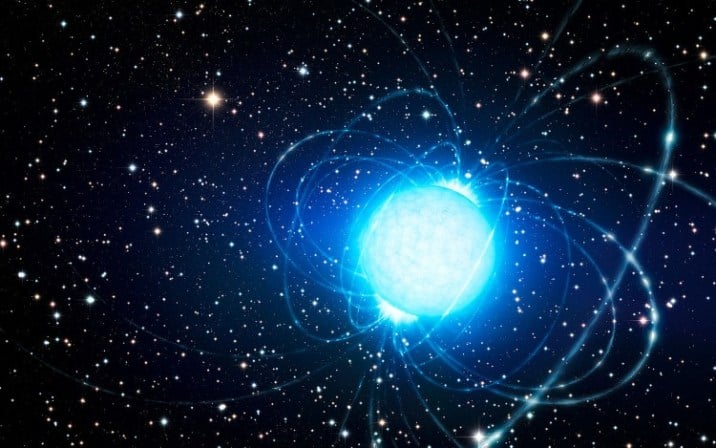
Some of the closest neutron stars to Earth are RX J1856.5 – 3754, situated at around 400 light-years away, and PSR J0108-1431, located at around 424 light-years away from us.
Neutron stars are only detectable with current technology, when they are in the earliest stages of their lives, often less than 1 million years. Theses young neutron stars are vastly outnumbered by older ones, that are only detectable through their blackbody radiation and gravitational effects on other stars.
Planets and Neutron Stars
Though it seems counterintuitive, neutron stars can host planets. These exoplanets can be original, circumbinary, captured, or the result of the second round of planet formation.
These planets receive little visible light yet massive amounts of ionizing radiation and high-energy stellar wind. This makes them very hostile environments, and life is unlikely to develop on them.
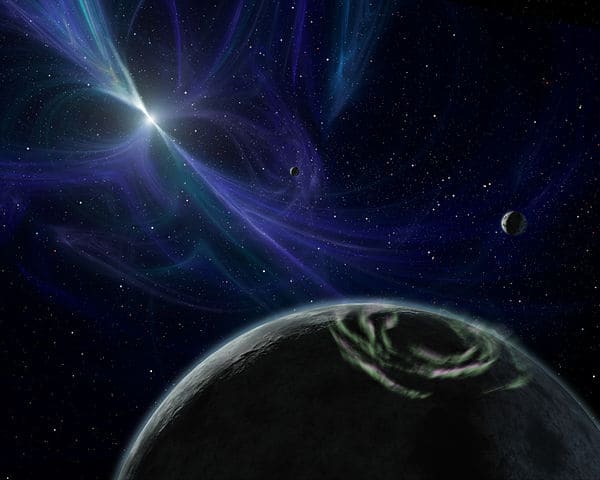
The first discovered exoplanets orbiting a neutron star are Draugr, Poltergeist, and Phoebetor, around the neutron star PSR B1257+12. They were discovered in 1992-94.
Draugr is also the smallest exoplanet currently known, having twice the mass of the Moon. Another example would be the PSR B1620-26, where a circumbinary planet orbits a neutron star-white dwarf binary system.
Did you know?
- Around 5% of all known neutron stars are members of binary systems.
- Binary systems that contain neutron stars often emit X-rays, which are emitted by hot gas as it falls towards the surface of the neutron star, the source of the gas being the companion star.
- Older neutron stars may take several seconds for each revolution – this is called spin down.
- The most rapidly rotating neutron star currently discovered is PSR J1748-2446ad. It rotates at around 716 revolutions per second.
- A neutron star that has temperatures of around 600,000 K, is over 100 times hotter than our Sun.
Sources:
Image sources:
- https://upload.wikimedia.org/wikipedia/en/thumb/1/18/Neutron_Star_gravitational_lensing.png/640px-Neutron_Star_gravitational_lensing.png
- https://upload.wikimedia.org/wikipedia/commons/thumb/c/c7/Neutronstarsimple.png/819px-Neutronstarsimple.png
- https://upload.wikimedia.org/wikipedia/commons/thumb/9/9e/Neutron_star_cross_section.svg/640px-Neutron_star_cross_section.svg.png
- https://astronomy.com/-/media/Images/News%20and%20Observing/News/2020/03/NeutronStar.jpg?mw=600
- https://images.theconversation.com/files/237878/original/file-20180925-149967-125y575.jpg?ixlib=rb-1.1.0&q=45&auto=format&w=1200&h=1200.0&fit=crop
- https://www.sciencealert.com/images/2019-09/processed/neutron-star-art_1024.jpg
- https://public.nrao.edu/wp-content/uploads/2006/01/imagessquared2007pulsargraphic07_squared-300x248.jpg
- https://i0.wp.com/www.rankred.com/wp-content/uploads/2018/08/magnetar.jpg?resize=716%2C448&ssl=1
- https://upload.wikimedia.org/wikipedia/commons/thumb/7/7c/Artist%27s_concept_of_PSR_B1257%2B12_system.jpg/600px-Artist%27s_concept_of_PSR_B1257%2B12_system.jpg
